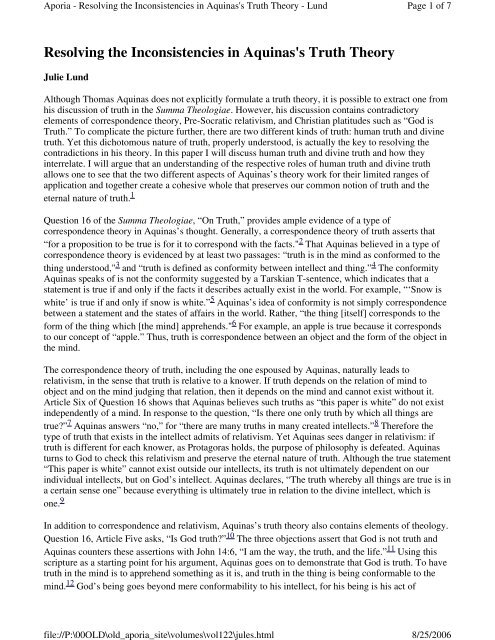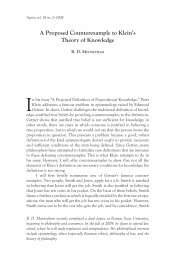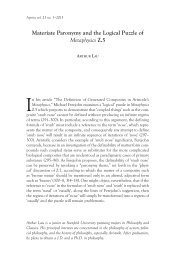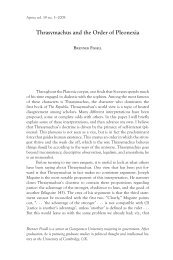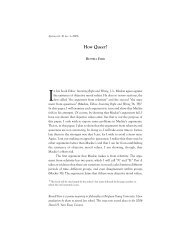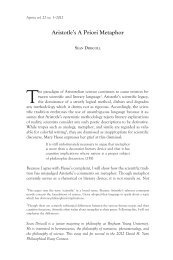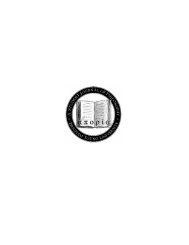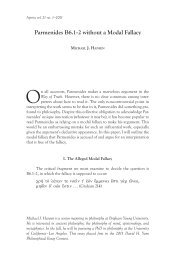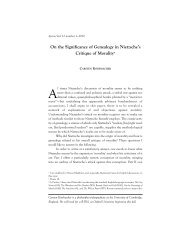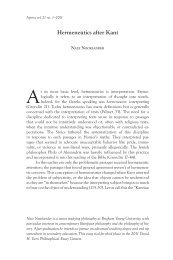Resolving the Inconsistencies in Aquinas's Truth Theory - Aporia
Resolving the Inconsistencies in Aquinas's Truth Theory - Aporia
Resolving the Inconsistencies in Aquinas's Truth Theory - Aporia
Create successful ePaper yourself
Turn your PDF publications into a flip-book with our unique Google optimized e-Paper software.
<strong>Aporia</strong> - <strong>Resolv<strong>in</strong>g</strong> <strong>the</strong> <strong>Inconsistencies</strong> <strong>in</strong> Aqu<strong>in</strong>as's <strong>Truth</strong> <strong>Theory</strong> - Lund<br />
file://P:\00OLD\old_aporia_site\volumes\vol122\jules.html<br />
Page 1 of 7<br />
8/25/2006<br />
<strong>Resolv<strong>in</strong>g</strong> <strong>the</strong> <strong>Inconsistencies</strong> <strong>in</strong> Aqu<strong>in</strong>as's <strong>Truth</strong> <strong>Theory</strong><br />
Julie Lund<br />
Although Thomas Aqu<strong>in</strong>as does not explicitly formulate a truth <strong>the</strong>ory, it is possible to extract one from<br />
his discussion of truth <strong>in</strong> <strong>the</strong> Summa Theologiae. However, his discussion conta<strong>in</strong>s contradictory<br />
elements of correspondence <strong>the</strong>ory, Pre-Socratic relativism, and Christian platitudes such as “God is<br />
<strong>Truth</strong>.” To complicate <strong>the</strong> picture fur<strong>the</strong>r, <strong>the</strong>re are two different k<strong>in</strong>ds of truth: human truth and div<strong>in</strong>e<br />
truth. Yet this dichotomous nature of truth, properly understood, is actually <strong>the</strong> key to resolv<strong>in</strong>g <strong>the</strong><br />
contradictions <strong>in</strong> his <strong>the</strong>ory. In this paper I will discuss human truth and div<strong>in</strong>e truth and how <strong>the</strong>y<br />
<strong>in</strong>terrelate. I will argue that an understand<strong>in</strong>g of <strong>the</strong> respective roles of human truth and div<strong>in</strong>e truth<br />
allows one to see that <strong>the</strong> two different aspects of Aqu<strong>in</strong>as’s <strong>the</strong>ory work for <strong>the</strong>ir limited ranges of<br />
application and toge<strong>the</strong>r create a cohesive whole that preserves our common notion of truth and <strong>the</strong><br />
eternal nature of truth. 1<br />
Question 16 of <strong>the</strong> Summa Theologiae, “On <strong>Truth</strong>,” provides ample evidence of a type of<br />
correspondence <strong>the</strong>ory <strong>in</strong> Aqu<strong>in</strong>as’s thought. Generally, a correspondence <strong>the</strong>ory of truth asserts that<br />
“for a proposition to be true is for it to correspond with <strong>the</strong> facts." 2 That Aqu<strong>in</strong>as believed <strong>in</strong> a type of<br />
correspondence <strong>the</strong>ory is evidenced by at least two passages: “truth is <strong>in</strong> <strong>the</strong> m<strong>in</strong>d as conformed to <strong>the</strong><br />
th<strong>in</strong>g understood," 3 and “truth is def<strong>in</strong>ed as conformity between <strong>in</strong>tellect and th<strong>in</strong>g.” 4 The conformity<br />
Aqu<strong>in</strong>as speaks of is not <strong>the</strong> conformity suggested by a Tarskian T-sentence, which <strong>in</strong>dicates that a<br />
statement is true if and only if <strong>the</strong> facts it describes actually exist <strong>in</strong> <strong>the</strong> world. For example, “‘Snow is<br />
white’ is true if and only if snow is white.” 5 Aqu<strong>in</strong>as’s idea of conformity is not simply correspondence<br />
between a statement and <strong>the</strong> states of affairs <strong>in</strong> <strong>the</strong> world. Ra<strong>the</strong>r, “<strong>the</strong> th<strong>in</strong>g [itself] corresponds to <strong>the</strong><br />
form of <strong>the</strong> th<strong>in</strong>g which [<strong>the</strong> m<strong>in</strong>d] apprehends." 6 For example, an apple is true because it corresponds<br />
to our concept of “apple.” Thus, truth is correspondence between an object and <strong>the</strong> form of <strong>the</strong> object <strong>in</strong><br />
<strong>the</strong> m<strong>in</strong>d.<br />
The correspondence <strong>the</strong>ory of truth, <strong>in</strong>clud<strong>in</strong>g <strong>the</strong> one espoused by Aqu<strong>in</strong>as, naturally leads to<br />
relativism, <strong>in</strong> <strong>the</strong> sense that truth is relative to a knower. If truth depends on <strong>the</strong> relation of m<strong>in</strong>d to<br />
object and on <strong>the</strong> m<strong>in</strong>d judg<strong>in</strong>g that relation, <strong>the</strong>n it depends on <strong>the</strong> m<strong>in</strong>d and cannot exist without it.<br />
Article Six of Question 16 shows that Aqu<strong>in</strong>as believes such truths as “this paper is white” do not exist<br />
<strong>in</strong>dependently of a m<strong>in</strong>d. In response to <strong>the</strong> question, “Is <strong>the</strong>re one only truth by which all th<strong>in</strong>gs are<br />
true?” 7 Aqu<strong>in</strong>as answers “no,” for “<strong>the</strong>re are many truths <strong>in</strong> many created <strong>in</strong>tellects.” 8 Therefore <strong>the</strong><br />
type of truth that exists <strong>in</strong> <strong>the</strong> <strong>in</strong>tellect admits of relativism. Yet Aqu<strong>in</strong>as sees danger <strong>in</strong> relativism: if<br />
truth is different for each knower, as Protagoras holds, <strong>the</strong> purpose of philosophy is defeated. Aqu<strong>in</strong>as<br />
turns to God to check this relativism and preserve <strong>the</strong> eternal nature of truth. Although <strong>the</strong> true statement<br />
“This paper is white” cannot exist outside our <strong>in</strong>tellects, its truth is not ultimately dependent on our<br />
<strong>in</strong>dividual <strong>in</strong>tellects, but on God’s <strong>in</strong>tellect. Aqu<strong>in</strong>as declares, “The truth whereby all th<strong>in</strong>gs are true is <strong>in</strong><br />
a certa<strong>in</strong> sense one” because everyth<strong>in</strong>g is ultimately true <strong>in</strong> relation to <strong>the</strong> div<strong>in</strong>e <strong>in</strong>tellect, which is<br />
one. 9<br />
In addition to correspondence and relativism, Aqu<strong>in</strong>as’s truth <strong>the</strong>ory also conta<strong>in</strong>s elements of <strong>the</strong>ology.<br />
Question 16, Article Five asks, “Is God truth?” 10 The three objections assert that God is not truth and<br />
Aqu<strong>in</strong>as counters <strong>the</strong>se assertions with John 14:6, “I am <strong>the</strong> way, <strong>the</strong> truth, and <strong>the</strong> life.” 11 Us<strong>in</strong>g this<br />
scripture as a start<strong>in</strong>g po<strong>in</strong>t for his argument, Aqu<strong>in</strong>as goes on to demonstrate that God is truth. To have<br />
truth <strong>in</strong> <strong>the</strong> m<strong>in</strong>d is to apprehend someth<strong>in</strong>g as it is, and truth <strong>in</strong> <strong>the</strong> th<strong>in</strong>g is be<strong>in</strong>g conformable to <strong>the</strong><br />
m<strong>in</strong>d. 12 God’s be<strong>in</strong>g goes beyond mere conformability to his <strong>in</strong>tellect, for his be<strong>in</strong>g is his act of
<strong>Aporia</strong> - <strong>Resolv<strong>in</strong>g</strong> <strong>the</strong> <strong>Inconsistencies</strong> <strong>in</strong> Aqu<strong>in</strong>as's <strong>Truth</strong> <strong>Theory</strong> - Lund<br />
file://P:\00OLD\old_aporia_site\volumes\vol122\jules.html<br />
Page 2 of 7<br />
8/25/2006<br />
know<strong>in</strong>g. S<strong>in</strong>ce God is his own be<strong>in</strong>g and his own act of know<strong>in</strong>g, truth not only resides <strong>in</strong> God, but “he<br />
is <strong>the</strong> supreme and orig<strong>in</strong>al truth.” 13<br />
The comb<strong>in</strong>ation of correspondence <strong>the</strong>ory, relativism, and <strong>the</strong>ology is confus<strong>in</strong>g without a proper<br />
understand<strong>in</strong>g of <strong>the</strong> different k<strong>in</strong>ds of truth. When Aqu<strong>in</strong>as refers to truth he does not always refer to<br />
<strong>the</strong> same truth. The major dist<strong>in</strong>ction he makes is between human truth and div<strong>in</strong>e truth, though <strong>the</strong>se<br />
are closely related. 14 Human truth is many, f<strong>in</strong>ite, and changeable, while div<strong>in</strong>e truth is one, eternal, and<br />
unchangeable. In <strong>the</strong> reply to Article 1 of question 16, he divides human truth <strong>in</strong>to <strong>in</strong>tellectual truth and<br />
truth <strong>in</strong> th<strong>in</strong>gs, <strong>the</strong> latter be<strong>in</strong>g divided <strong>in</strong>to man-made th<strong>in</strong>gs and natural th<strong>in</strong>gs. Aqu<strong>in</strong>as ascribes truth<br />
to th<strong>in</strong>gs <strong>the</strong>mselves (both man-made and natural), propositions or statements about th<strong>in</strong>gs, and God.<br />
The truth of al of <strong>the</strong>se depends on some sort of correspondence. For example, Aqu<strong>in</strong>as would attribute<br />
truth to both a build<strong>in</strong>g and God. A true build<strong>in</strong>g is one that conforms to our concept of a build<strong>in</strong>g, while<br />
God is true because his be<strong>in</strong>g corresponds perfectly to his <strong>in</strong>tellect, s<strong>in</strong>ce his be<strong>in</strong>g is equivalent to his<br />
know<strong>in</strong>g. The difference is <strong>the</strong> truth of <strong>the</strong> build<strong>in</strong>g can change because it is relative to man, but <strong>the</strong><br />
truth of God cannot change.<br />
Human truth is def<strong>in</strong>ed as conformity between an object and <strong>the</strong> concept <strong>in</strong> man’s <strong>in</strong>tellect, and is thus<br />
dependent on man. It <strong>in</strong>cludes both truth <strong>in</strong> <strong>the</strong> human <strong>in</strong>tellect and truth <strong>in</strong> th<strong>in</strong>gs. S<strong>in</strong>ce human truth is<br />
dependent on man, it is nei<strong>the</strong>r eternal nor unchangeable, s<strong>in</strong>ce human be<strong>in</strong>gs possess nei<strong>the</strong>r<br />
characteristic. When Aqu<strong>in</strong>as speaks of conformity of m<strong>in</strong>d to th<strong>in</strong>g, he is us<strong>in</strong>g correspondence <strong>the</strong>ory<br />
to illustrate <strong>the</strong> nature of human truth. This makes even <strong>the</strong> truth of th<strong>in</strong>gs relative to our <strong>in</strong>tellects,<br />
because th<strong>in</strong>gs are not true but <strong>in</strong> virtue of <strong>the</strong>ir relation to man’s <strong>in</strong>tellect. Aqu<strong>in</strong>as sees this relativism<br />
as a fur<strong>the</strong>r demonstration of <strong>the</strong> f<strong>in</strong>itude of man as compared with <strong>the</strong> majesty of God. Although we are<br />
created <strong>in</strong> God’s image and share with him <strong>the</strong> ability to create truth, we can never create eternal,<br />
unchangeable truth. Human truth, because it is relative, is changeable.<br />
Properly speak<strong>in</strong>g, truth is only <strong>in</strong> <strong>the</strong> <strong>in</strong>tellect. However, Aqu<strong>in</strong>as grants that th<strong>in</strong>gs also possess a type<br />
of truth. <strong>Truth</strong> is “secondarily <strong>in</strong> th<strong>in</strong>gs, by virtue of a relation to <strong>in</strong>tellect as to <strong>the</strong>ir orig<strong>in</strong>.” 15 Th<strong>in</strong>gs<br />
are true because <strong>the</strong>y possess an essential relation to <strong>the</strong> m<strong>in</strong>d, ei<strong>the</strong>r human or div<strong>in</strong>e. A relation is<br />
essential if <strong>the</strong> th<strong>in</strong>g depends on <strong>the</strong> m<strong>in</strong>d for its existence, while a relation is <strong>in</strong>cidental if <strong>the</strong> th<strong>in</strong>g can<br />
be known by <strong>the</strong> m<strong>in</strong>d, but it still exists without <strong>the</strong> m<strong>in</strong>d’s knowledge of it. “Thus we might say that a<br />
house has an essential relation to <strong>the</strong> architect’s m<strong>in</strong>d but an <strong>in</strong>cidental one to a m<strong>in</strong>d on which it does<br />
not depend.” 16 Man-made th<strong>in</strong>gs are dependent on human m<strong>in</strong>ds and natural th<strong>in</strong>gs are dependent on <strong>the</strong><br />
div<strong>in</strong>e m<strong>in</strong>d. A th<strong>in</strong>g is said to be true because its existence depends on ei<strong>the</strong>r <strong>the</strong> div<strong>in</strong>e m<strong>in</strong>d or <strong>the</strong><br />
human m<strong>in</strong>d.<br />
All natural th<strong>in</strong>gs, like trees and mounta<strong>in</strong>s and rocks, are true because <strong>the</strong>y “bear a likeness to <strong>the</strong> types<br />
<strong>in</strong> <strong>the</strong> div<strong>in</strong>e m<strong>in</strong>d.” 17 Aqu<strong>in</strong>as gives <strong>the</strong> example of a stone be<strong>in</strong>g true when it has <strong>the</strong> qualities that<br />
stones should have, accord<strong>in</strong>g to God’s conception of a stone. So perhaps a gra<strong>in</strong> of sand is not a true<br />
stone because God’s conception of stone <strong>in</strong>cludes be<strong>in</strong>g at least big enough to hurt when hurled from a<br />
sl<strong>in</strong>gshot at your face. But this does not mean <strong>the</strong> gra<strong>in</strong> of sand is essentially false. Although <strong>the</strong> gra<strong>in</strong> of<br />
sand is not a true stone, it is a true gra<strong>in</strong> of sand, because it has <strong>the</strong> qualities God th<strong>in</strong>ks are essential to a<br />
gra<strong>in</strong> of sand. For example, <strong>the</strong> essence of a gra<strong>in</strong> of sand might <strong>in</strong>clude caus<strong>in</strong>g pa<strong>in</strong> when it gets <strong>in</strong><br />
your eye. The conformability to this essence becomes obvious if you put <strong>the</strong> gra<strong>in</strong> of sand <strong>in</strong> your eye.<br />
The truth of natural th<strong>in</strong>gs ultimately depends on <strong>the</strong> div<strong>in</strong>e <strong>in</strong>tellect and not <strong>the</strong> human <strong>in</strong>tellect because<br />
natural th<strong>in</strong>gs were created by God, not man. Natural th<strong>in</strong>gs still bear an <strong>in</strong>cidental relation to man’s<br />
<strong>in</strong>tellect for man can know natural th<strong>in</strong>gs, but man’s knowledge of <strong>the</strong> th<strong>in</strong>g is not necessary to <strong>the</strong><br />
th<strong>in</strong>g’s existence. Thus a stone miles beneath <strong>the</strong> earth’s surface that no human has ever thought of is<br />
still true because it bears a relation to <strong>the</strong> div<strong>in</strong>e m<strong>in</strong>d. The truth of natural th<strong>in</strong>gs is not relative to<br />
humans but to God.
<strong>Aporia</strong> - <strong>Resolv<strong>in</strong>g</strong> <strong>the</strong> <strong>Inconsistencies</strong> <strong>in</strong> Aqu<strong>in</strong>as's <strong>Truth</strong> <strong>Theory</strong> - Lund<br />
file://P:\00OLD\old_aporia_site\volumes\vol122\jules.html<br />
Page 3 of 7<br />
8/25/2006<br />
It is easier for man to judge <strong>the</strong> truth of man-made th<strong>in</strong>gs, s<strong>in</strong>ce <strong>the</strong>ir existence depends on our m<strong>in</strong>ds.<br />
For example, we might def<strong>in</strong>e a sock as an article of cloth<strong>in</strong>g one wears on one’s feet, which seems to<br />
leave out w<strong>in</strong>d socks. Our def<strong>in</strong>ition is cont<strong>in</strong>gent because a sock is a man-made object. We can judge<br />
that a w<strong>in</strong>d sock is not a true sock, accord<strong>in</strong>g to our def<strong>in</strong>ition and conception of a sock. The truth of<br />
man-made objects is dependent on our conception, which makes this truth relative. People <strong>in</strong> different<br />
cultures and ages have different uses for similar objects, and so have different truth conditions for <strong>the</strong>m.<br />
For example, an American would say a black ankle sock was a true sock, but perhaps someone from a<br />
different country, where everyone only wears red, knee-high socks, would disagree. The truth of manmade<br />
objects is relative and changeable.<br />
This mutability also applies to language, which Aqu<strong>in</strong>as considers to be a man-made object. His brief<br />
discussion of <strong>the</strong> truth of language could easily fit <strong>in</strong>to contemporary truth/language debates. Aqu<strong>in</strong>as<br />
speaks of <strong>the</strong> truth of propositions <strong>in</strong> two ways. The first way a proposition is true is <strong>in</strong> <strong>the</strong> same sense<br />
any o<strong>the</strong>r th<strong>in</strong>g is true, by fulfill<strong>in</strong>g what is determ<strong>in</strong>ed for it by <strong>the</strong> div<strong>in</strong>e <strong>in</strong>tellect. For propositions,<br />
this means it must be grammatical, well-formed, and thus mean<strong>in</strong>gful. “Asdiuo noiuet nviso ewsn” is<br />
not a true proposition <strong>in</strong> this sense. Thus, Aqu<strong>in</strong>as says, any well-formed, grammatical comb<strong>in</strong>ation of<br />
words is true, even if it fails to represent a conformity between human <strong>in</strong>tellect and th<strong>in</strong>g. 18 The second<br />
way a proposition is true is if it does <strong>in</strong> fact <strong>in</strong>dicate a conformity between <strong>in</strong>tellect and th<strong>in</strong>g. Aqu<strong>in</strong>as<br />
illustrates this dist<strong>in</strong>ction with <strong>the</strong> follow<strong>in</strong>g example:<br />
When Socrates is seated <strong>the</strong> proposition “Socrates is seated” is true with <strong>the</strong> truth that<br />
belongs to th<strong>in</strong>gs, as a formula of words with mean<strong>in</strong>g; and also with truth that belongs to<br />
mean<strong>in</strong>g, as <strong>in</strong>dicat<strong>in</strong>g a true op<strong>in</strong>ion. When Socrates rises, its truth <strong>in</strong> <strong>the</strong> first sense<br />
rema<strong>in</strong>s, but its truth <strong>in</strong> <strong>the</strong> second sense changes. 19<br />
Thus a well-formed, grammatical statement is always true <strong>in</strong> <strong>the</strong> first sense, even if it does not conform<br />
to reality. But <strong>in</strong> <strong>the</strong> second sense, <strong>in</strong> reference to its mean<strong>in</strong>g, <strong>the</strong> truth of a statement changes when it<br />
no longer conforms to reality.<br />
Most contemporary discussions on truth are centered on <strong>the</strong> truth of propositions. Ei<strong>the</strong>r <strong>the</strong>y claim that<br />
propositions are eternally true or <strong>the</strong>y claim that “propositions about creatures are not eternally true, but<br />
beg<strong>in</strong> to be true when th<strong>in</strong>gs come to be and lose <strong>the</strong>ir truth when th<strong>in</strong>gs perish.” 20 Frege claimed that<br />
propositions are eternally true when supplemented by a time-<strong>in</strong>dication. A sentence like ‘this tree is<br />
covered with green leaves’ uttered <strong>in</strong> June does not become false <strong>in</strong> November. Ra<strong>the</strong>r, it is eternally<br />
true that <strong>the</strong> tree is covered with green leaves <strong>in</strong> that particular month of June. 21 Aqu<strong>in</strong>as disagrees with<br />
this. In Question 16, Article 8, Aqu<strong>in</strong>as expla<strong>in</strong>s that <strong>the</strong> truth of a statement does change when <strong>the</strong><br />
relation between <strong>in</strong>tellect and object changes. This relation can change if ei<strong>the</strong>r <strong>the</strong> <strong>in</strong>tellect changes or<br />
<strong>the</strong> object changes. A person can change his op<strong>in</strong>ion about someth<strong>in</strong>g that rema<strong>in</strong>s <strong>the</strong> same, or an<br />
object can change while <strong>the</strong> op<strong>in</strong>ion someone holds of it rema<strong>in</strong>s <strong>the</strong> same. This is seen <strong>in</strong> <strong>the</strong> above<br />
example of Socrates stand<strong>in</strong>g up, which makes <strong>the</strong> formerly true statement, “Socrates is seated,” false.<br />
Ei<strong>the</strong>r a change <strong>in</strong> op<strong>in</strong>ion or a change <strong>in</strong> <strong>the</strong> object can cause shifts from truth to falsity because <strong>the</strong><br />
m<strong>in</strong>d and <strong>the</strong> object no longer conform.<br />
But what about statements we call eternally true, such as tautologies or arithmetic truths? It seems like<br />
“2+2=4” bears an <strong>in</strong>cidental relation to <strong>the</strong> human <strong>in</strong>tellect, s<strong>in</strong>ce it is true whe<strong>the</strong>r we th<strong>in</strong>k it is or not.<br />
This would mean its truth is not relative to our m<strong>in</strong>d and thus has <strong>in</strong>dependent existence. Aqu<strong>in</strong>as<br />
addresses this issue <strong>in</strong> Article Seven of Question 16, “Is Created <strong>Truth</strong> Eternal?” Tautological<br />
statements possess truth because <strong>the</strong>y are well-formed and grammatical. But <strong>the</strong>y also possess truth<br />
because <strong>the</strong>y <strong>in</strong>dicate truth <strong>in</strong> our <strong>in</strong>tellect by bear<strong>in</strong>g a relation to our m<strong>in</strong>ds. “Hence, if no <strong>in</strong>tellect<br />
were eternal, no truth would be eternal. But s<strong>in</strong>ce <strong>the</strong> div<strong>in</strong>e <strong>in</strong>tellect alone is eternal, truth has eternity
<strong>Aporia</strong> - <strong>Resolv<strong>in</strong>g</strong> <strong>the</strong> <strong>Inconsistencies</strong> <strong>in</strong> Aqu<strong>in</strong>as's <strong>Truth</strong> <strong>Theory</strong> - Lund<br />
file://P:\00OLD\old_aporia_site\volumes\vol122\jules.html<br />
Page 4 of 7<br />
8/25/2006<br />
<strong>in</strong> it alone.” 22 Our m<strong>in</strong>d can have <strong>the</strong> thought of a “necessarily true” statement, but s<strong>in</strong>ce our m<strong>in</strong>ds are<br />
not eternal, nei<strong>the</strong>r is <strong>the</strong> true statement, relative to us. Necessarily true statements exist <strong>in</strong>dependently<br />
of us, but not of God. Their eternal truth comes from <strong>the</strong>ir relation to God’s <strong>in</strong>tellect.<br />
Once Aqu<strong>in</strong>as shows that propositions can change, it follows that <strong>the</strong> truth of <strong>the</strong>ories, such as <strong>the</strong><br />
Ptolemaic system, can also change. Dur<strong>in</strong>g <strong>the</strong> time that <strong>the</strong> Ptolemaic system was generally accepted, it<br />
would have been said to be true <strong>in</strong> relation to our m<strong>in</strong>ds, s<strong>in</strong>ce it was a man-made <strong>the</strong>ory. It bore an<br />
essential relation to <strong>the</strong> human m<strong>in</strong>d. However, it would not have possessed div<strong>in</strong>e truth, s<strong>in</strong>ce it could<br />
not have conformed to an idea <strong>in</strong> God’s <strong>in</strong>tellect. This is because God would have <strong>the</strong>n possessed a false<br />
idea, which is impossible. But now it is not even true <strong>in</strong> relation to our m<strong>in</strong>ds because our m<strong>in</strong>ds no<br />
longer conform to that idea. This is a more satisfactory explanation than <strong>the</strong> one offered by James,<br />
which states that Ptolemy’s system was and is, even now, “relatively true, or true with<strong>in</strong> those borders of<br />
experience.” 23 It seems wrong to call it true <strong>in</strong> any sense at this time, when we know that it is false. It is<br />
more <strong>in</strong>tuitive to say that it possessed human truth and not div<strong>in</strong>e truth before, and possesses nei<strong>the</strong>r<br />
now. S<strong>in</strong>ce God can never be mistaken, <strong>the</strong> truth of his m<strong>in</strong>d is unchangeable, which means <strong>the</strong>re is an<br />
immutable truth.<br />
Immutable truth is necessary to philosophy. Philosophers draw from past philosophers. They accept,<br />
reject, or modify past arguments accord<strong>in</strong>g to <strong>the</strong>ir strengths and weaknesses. We often speak of<br />
philosophers <strong>in</strong> terms of <strong>the</strong>ir contributions to philosophy, which implies that philosophy is a timeless<br />
pursuit <strong>in</strong> which all can participate regardless of <strong>the</strong> time or place <strong>in</strong> which <strong>the</strong>y personally exist. This is<br />
possible because philosophers, for <strong>the</strong> most part, believe <strong>the</strong>mselves to be engaged <strong>in</strong> <strong>the</strong> search for<br />
truth, a universal truth that transcends <strong>the</strong> constra<strong>in</strong>ts of time. With few exceptions, philosophers from<br />
<strong>the</strong> Pre-Socratics to Descartes and Leibniz adhered to this idea. However, recent deflationists claim that<br />
<strong>the</strong>re is noth<strong>in</strong>g <strong>in</strong>terest<strong>in</strong>g to say about truth <strong>in</strong> general. Simmons and Blackburn po<strong>in</strong>t out that “if <strong>the</strong>re<br />
is noth<strong>in</strong>g to say about truth <strong>in</strong> general, this may seem to imply that <strong>the</strong>re is noth<strong>in</strong>g to say about <strong>the</strong><br />
relationship between m<strong>in</strong>d and world <strong>in</strong> general. And if that topic is denied us, <strong>the</strong>n much of philosophy<br />
seems to disappear with it.” 24 Unlike <strong>the</strong> recent deflationary <strong>the</strong>orists, Thomas Aqu<strong>in</strong>as affirms that one<br />
can say someth<strong>in</strong>g about truth: that it does <strong>in</strong> fact exist, and moreover exists eternally. He calls this truth<br />
div<strong>in</strong>e truth. 25<br />
Aqu<strong>in</strong>as “refers <strong>the</strong> whole eternity of truth to <strong>the</strong> div<strong>in</strong>e m<strong>in</strong>d.” 26 This precludes <strong>the</strong> <strong>in</strong>dependent eternal<br />
truth of necessary propositions, which seems odd, but this issue was addressed above. Aqu<strong>in</strong>as teaches<br />
that <strong>the</strong>re is only one eternal truth, <strong>the</strong> truth of God’s <strong>in</strong>tellect. Maurer outl<strong>in</strong>es Aqu<strong>in</strong>as’s argument for<br />
one eternal truth:<br />
This follows from <strong>the</strong> fact that truth is be<strong>in</strong>g, and <strong>the</strong> conformity of m<strong>in</strong>d to be<strong>in</strong>g. Hence<br />
anyth<strong>in</strong>g is related to truth as it is related to be<strong>in</strong>g...Now only <strong>the</strong> div<strong>in</strong>e be<strong>in</strong>g and <strong>the</strong> m<strong>in</strong>d<br />
are eternal. The conclusion is <strong>in</strong>evitable: only <strong>the</strong> div<strong>in</strong>e truth is eternal; and s<strong>in</strong>ce <strong>the</strong>re is<br />
only one div<strong>in</strong>e m<strong>in</strong>d, <strong>the</strong>re is only one eternal truth. 27<br />
So, div<strong>in</strong>e truth is one, eternal, and immutable. Also, “it is at once <strong>the</strong> orig<strong>in</strong> and goal of human truth.” 28<br />
It is what humans aim at <strong>in</strong> <strong>the</strong>ir pursuit of truth.<br />
How can div<strong>in</strong>e truth be both <strong>the</strong> orig<strong>in</strong> and goal of human truth? God cannot be <strong>the</strong> orig<strong>in</strong> of human<br />
truth <strong>in</strong> <strong>the</strong> sense of him creat<strong>in</strong>g human truth, for human truth is created by men. Never<strong>the</strong>less, human<br />
truth would not exist without God, s<strong>in</strong>ce he created humans, <strong>the</strong> objects <strong>the</strong>y encounter and to which<br />
<strong>the</strong>y relate, and <strong>the</strong> manner of that relation as correspondence. And div<strong>in</strong>e truth is <strong>the</strong> standard of<br />
judgment that determ<strong>in</strong>es <strong>the</strong> truth of <strong>the</strong> relations between <strong>the</strong> object and <strong>the</strong> m<strong>in</strong>d. As stated before,
<strong>Aporia</strong> - <strong>Resolv<strong>in</strong>g</strong> <strong>the</strong> <strong>Inconsistencies</strong> <strong>in</strong> Aqu<strong>in</strong>as's <strong>Truth</strong> <strong>Theory</strong> - Lund<br />
file://P:\00OLD\old_aporia_site\volumes\vol122\jules.html<br />
Page 5 of 7<br />
8/25/2006<br />
objects are true <strong>in</strong> virtue of <strong>the</strong>ir relation to <strong>the</strong> div<strong>in</strong>e m<strong>in</strong>d, and so are also true if <strong>the</strong>ir relation to a<br />
human m<strong>in</strong>d is faithful to <strong>the</strong> div<strong>in</strong>e truth. So, div<strong>in</strong>e truth is <strong>the</strong> orig<strong>in</strong> of human truth. It is also its goal,<br />
<strong>in</strong> a certa<strong>in</strong> sense. We cannot ever achieve or fully know div<strong>in</strong>e truth, but we seek to have <strong>the</strong> greatest<br />
possible understand<strong>in</strong>g of it so that we may better judge human truth. We do not know if we are relat<strong>in</strong>g<br />
to <strong>the</strong> world correctly unless we know how God relates to <strong>the</strong> world, which is <strong>the</strong> div<strong>in</strong>e truth. Thus,<br />
div<strong>in</strong>e truth is both <strong>the</strong> orig<strong>in</strong> and goal of human truth.<br />
There are both weaknesses and strengths of Aqu<strong>in</strong>as’s <strong>the</strong>ory. It seems odd to be speak<strong>in</strong>g of Aqu<strong>in</strong>as’s<br />
<strong>the</strong>ory of truth <strong>in</strong> <strong>the</strong> midst of <strong>the</strong> generally accepted deflationary <strong>the</strong>ories. Aqu<strong>in</strong>as believes it is not<br />
only worthwhile to discuss truth, but that it is actually possible to def<strong>in</strong>e it. His <strong>the</strong>ory may seem a bit<br />
antiquated, but it has strength. Most importantly, Aqu<strong>in</strong>as preserves eternal truth by equat<strong>in</strong>g it with<br />
God. This is comfort<strong>in</strong>g to those who believe that God is not dead. Fur<strong>the</strong>r, it preserves <strong>the</strong> very object<br />
of philosophical pursuit. Along with this, Aqu<strong>in</strong>as def<strong>in</strong>es truth <strong>in</strong> a way that is natural for us to th<strong>in</strong>k<br />
about it. One does not objectively compare statements and thoughts to facts to see if <strong>the</strong>y correspond.<br />
For example, if someone says to us, “snow is white,” we do not look out <strong>the</strong> w<strong>in</strong>dow to assess <strong>the</strong> facts<br />
and see if <strong>the</strong>y correspond to <strong>the</strong> statement. The truth of <strong>the</strong> idea is immediately present to us because<br />
we th<strong>in</strong>k of snow as be<strong>in</strong>g white. Aqu<strong>in</strong>as also allows for <strong>the</strong> falsity that we experience when our<br />
judgments or <strong>the</strong> th<strong>in</strong>gs we judge change. We are never naturally tempted to th<strong>in</strong>k that “Socrates is<br />
seated” and “Socrates is stand<strong>in</strong>g” can both be true at <strong>the</strong> same time, or that “The geocentric <strong>the</strong>ory is<br />
true” and “The heliocentric <strong>the</strong>ory is true” can both be true, s<strong>in</strong>ce <strong>the</strong>y are contradictory.<br />
However, <strong>the</strong>re are also weaknesses <strong>in</strong> Aqu<strong>in</strong>as’s argument. Those who believe God does not exist will<br />
not accept <strong>the</strong> concept of div<strong>in</strong>e truth. Once div<strong>in</strong>e truth is elim<strong>in</strong>ated, one is left with a basic<br />
correspondence <strong>the</strong>ory and <strong>the</strong> accompany<strong>in</strong>g problems, such as relativity, mutability, and <strong>the</strong> notorious<br />
problem of how an idea corresponds to an object. Also, it seems imprecise to call so many different<br />
types of truth by <strong>the</strong> same name. Aqu<strong>in</strong>as’s only justification for do<strong>in</strong>g this is that we do <strong>the</strong> same th<strong>in</strong>g<br />
by call<strong>in</strong>g different th<strong>in</strong>gs true, and so it conforms to <strong>the</strong> way we naturally speak of truth. By work<strong>in</strong>g<br />
with so many different types of truth, it seems he fails to capture <strong>the</strong> essence of truth. But <strong>in</strong> fact, he<br />
succeeds <strong>in</strong> captur<strong>in</strong>g truth’s essence better than most philosophers, for he recognizes that truth’s<br />
essence is not limited to just <strong>the</strong> truth of propositions or just to God as truth, or just to <strong>the</strong> truth of<br />
existent th<strong>in</strong>gs. He encompasses all of <strong>the</strong>se aspects of truth <strong>in</strong> his <strong>the</strong>ory.<br />
Never<strong>the</strong>less, this broad discussion of truth leads to lack of clarity <strong>in</strong> his argument, ano<strong>the</strong>r weakness.<br />
Sometimes Aqu<strong>in</strong>as seems like a traditional correspondence <strong>the</strong>orist, like when he says, “<strong>Truth</strong> is<br />
def<strong>in</strong>ed as conformity between <strong>in</strong>tellect and th<strong>in</strong>g.” 29 O<strong>the</strong>r times he seems like a Heideggerian, such as<br />
when he says, “You f<strong>in</strong>d truth <strong>in</strong> <strong>the</strong> m<strong>in</strong>d when it apprehends <strong>the</strong> th<strong>in</strong>g as it is, and truth <strong>in</strong> <strong>the</strong> th<strong>in</strong>g<br />
when it possesses be<strong>in</strong>g conformable to <strong>the</strong> m<strong>in</strong>d.” 30 This does not suggest traditional correspondence,<br />
but ra<strong>the</strong>r Heidegger’s idea of truth as uncover<strong>in</strong>g, as appropriated from Pre-Platonic philosophy.<br />
Confusion also arises because Aqu<strong>in</strong>as says <strong>the</strong> truth of th<strong>in</strong>gs can change because <strong>the</strong>ir truth is<br />
dependent on our apprehension of it, which varies from person to person. Then he says <strong>the</strong> truth of<br />
th<strong>in</strong>gs cannot change because <strong>the</strong>ir truth is dependent on its relation to <strong>the</strong> div<strong>in</strong>e <strong>in</strong>tellect, which is<br />
unchangeable and all-know<strong>in</strong>g. This lack of clarity is understandable, though. Aqu<strong>in</strong>as’s truth <strong>the</strong>ory<br />
would naturally be unclear, s<strong>in</strong>ce he never explicitly sets it forth as a <strong>the</strong>ory of truth. One must formulate<br />
his <strong>the</strong>ory of truth based on his discussion of truth, which is not systematic by our standards.<br />
Aqu<strong>in</strong>as’s <strong>the</strong>ory of truth could be described with <strong>the</strong> motto “Divide and conquer.” He divides truth <strong>in</strong>to<br />
human truth and div<strong>in</strong>e truth and addresses <strong>the</strong>m separately. He uses correspondence <strong>the</strong>ory to expla<strong>in</strong><br />
human truth, both <strong>in</strong> our <strong>in</strong>tellect and <strong>in</strong> th<strong>in</strong>gs. This makes human truth many, f<strong>in</strong>ite, and changeable.<br />
But div<strong>in</strong>e truth compensates for <strong>the</strong>se “fail<strong>in</strong>gs” because it is one, <strong>in</strong>f<strong>in</strong>ite, and unchangeable. The<br />
correspondence <strong>the</strong>ory seems <strong>in</strong>tuitive and it describes how we normally th<strong>in</strong>k of truth and how we use
<strong>Aporia</strong> - <strong>Resolv<strong>in</strong>g</strong> <strong>the</strong> <strong>Inconsistencies</strong> <strong>in</strong> Aqu<strong>in</strong>as's <strong>Truth</strong> <strong>Theory</strong> - Lund<br />
file://P:\00OLD\old_aporia_site\volumes\vol122\jules.html<br />
Page 6 of 7<br />
8/25/2006<br />
it <strong>in</strong> our lives. At <strong>the</strong> same time, Aqu<strong>in</strong>as’s use of <strong>the</strong>ology ma<strong>in</strong>ta<strong>in</strong>s <strong>the</strong> o<strong>the</strong>r aspect of truth that we<br />
normally th<strong>in</strong>k of: its eternal, immutable nature. Aqu<strong>in</strong>as offers a truth <strong>the</strong>ory that encompasses <strong>the</strong> best<br />
of both worlds to offer a complete picture of truth.<br />
Notes<br />
1. The "common notion" of truth spoken of here is <strong>the</strong> idea that true thoughts and statements are those<br />
that correspond to <strong>the</strong> facts.<br />
2. Simon Blackburn and Keith Simmons, <strong>Truth</strong> (Oxford: Oxford University Press, 1999) 1.<br />
3. St. Thomas Aqu<strong>in</strong>as, Summa Theologiae, Volume 4: Knowledge <strong>in</strong> God (Great Brita<strong>in</strong>: Eyre and<br />
Scottiswood Limited, 1964) 77.<br />
4. Aqu<strong>in</strong>as 81.<br />
5. All correspondence <strong>the</strong>ories state that true statements correspond with <strong>the</strong> facts, but Alfred Tarski is<br />
responsible for devis<strong>in</strong>g <strong>the</strong> T-sentence formulation to express this correspondence.<br />
6. Aqu<strong>in</strong>as 81.<br />
7. Aqu<strong>in</strong>as 89.<br />
8. Aqu<strong>in</strong>as 91.<br />
9. Aqu<strong>in</strong>as 91.<br />
10. Aqu<strong>in</strong>as 87.<br />
11. Aqu<strong>in</strong>as 87.<br />
12. Though we normally ascribe truth to statements and propositions, Aqu<strong>in</strong>as does assert that truth also<br />
resides <strong>in</strong> th<strong>in</strong>gs.<br />
13. Aqu<strong>in</strong>as 89.<br />
14. Aqu<strong>in</strong>as 89.<br />
15. Aqu<strong>in</strong>as 81.<br />
16. Aqu<strong>in</strong>as 77.<br />
17. Aqu<strong>in</strong>as 77.<br />
18. Aqu<strong>in</strong>as 99.<br />
19. Aqu<strong>in</strong>as 99.<br />
20. Armand Maurer, C.S.B., St. Thomas and Historicity (Milwaukee: Marquette University Press, 1979)
<strong>Aporia</strong> - <strong>Resolv<strong>in</strong>g</strong> <strong>the</strong> <strong>Inconsistencies</strong> <strong>in</strong> Aqu<strong>in</strong>as's <strong>Truth</strong> <strong>Theory</strong> - Lund<br />
file://P:\00OLD\old_aporia_site\volumes\vol122\jules.html<br />
Page 7 of 7<br />
8/25/2006<br />
25.<br />
21. Gottlob Frege, "The Thought: A Logical Inquiry," trans. A.M. and Marcelle Qu<strong>in</strong>ton. Repr<strong>in</strong>ted <strong>in</strong><br />
<strong>Truth</strong>, Simon Blackburn and Keith Simmons (Oxford: Oxford University Press, 1999), 103.<br />
22. Aqu<strong>in</strong>as 93.<br />
23. William James, "Pragmatism's Conception of <strong>Truth</strong>," pr<strong>in</strong>ted <strong>in</strong> <strong>Truth</strong>, Blackburn and Simmons, 63.<br />
24. Blackburn and Simmons 3.<br />
25. Maurer 21-24.<br />
26. qtd. <strong>in</strong> Maurer 25.<br />
27. Maurer 26.<br />
28. Maurer 36.<br />
29. Aqu<strong>in</strong>as 81.<br />
30. Aqu<strong>in</strong>as 89, italics added.


